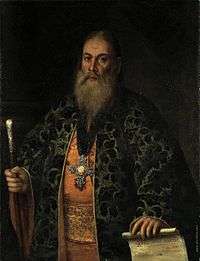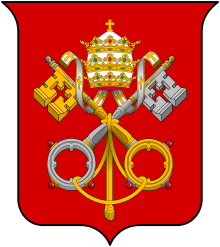Archpriest
The ecclesiastical title of archpriest or archpresbyter belongs to certain priests with supervisory duties over a number of parishes. The term is most often used in Eastern Orthodoxy and the Eastern Catholic Churches and may be somewhat analogous to a monsignor in the Latin Church, but in the Eastern churches an archpriest wears an additional vestment and, typically, a pectoral cross, and becomes an archpriest via a liturgical ceremony.
The term may be used in the Roman Catholic Church instead of dean or vicar forane.
In the 16th and 17th centuries, during the persecution of Catholics in England, an archpriest appointed from Rome had authority over all of the church's secular clergy in the country. In the present-day Church of England, a rural or area dean resembles an archpriest. In the Roman Catholic Church, traditionally a priest's first Mass has an archpriest assisting the newly ordained priest, functioning as the deacon otherwise does, but this is only for that event.
Antiquity
In ancient times, the archdeacon was the head of the diaconate of a diocese, as is still the case in the Eastern Orthodox Church, while the archpriest was first the chief of the presbyterium of the diocese. His duties included deputising for the bishop in spiritual matters when necessary.
Western Christianity
Latin Catholic Church
In the western church, by the Middle Ages, the title had evolved and was that of the priest of the principal parish among several local parishes. This priest had general charge of worship in this archpresbyterate, and the parishioners of the smaller parishes had to attend Sunday Mass and hold baptisms at the principal parish while the subordinate parishes instead held daily mass and homilies.
Exceptionally, the pope could elevate one to the rank of archipresbyterate nullius, detached from any prelature, yet under a non-prelate, as happened in 1471 with the future abbacy (1583) and (since 1828) bishopric of Guastalla.
By the time of the Council of Trent the office of archpriest was replaced by the office of vicar forane, also known in English as "dean". The first recorded use of this meaning of the title comes from St Charles Borromeo's reforms in his own diocese. Unlike vicars general and vicars episcopal, vicars forane are not prelates, which means they do not possess ordinary power. Their role is entirely supervisory, and they perform visitations for the bishop and report to the bishop or vicar general any problems in their vicariate.
From late Elizabethan England until 1623, an archpriest was appointed from Rome to oversee the Roman Catholic Church's mission in England, with authority over all secular clergy in the country.[1]
The title of archpriest has survived in Rome, in Malta and elsewhere, where it is now held by the rectors of the major basilicas. However, the title is entirely honorary, reflecting the fact that these churches held archpriestly status in the past.
There are four archpriests, for each of the four papal major basilicas in Rome, all of whom presently are bishops :
- Archbasilica of Saint John Lateran
- Basilica di Santa Maria Maggiore
- Basilica of Saint Paul Outside the Walls
- St. Peter's Basilica
Many churches (thousands) in the world, other than basilicas, have the right to be governed by an archpriest, according to the specific historical tradition. Hence, the title is mostly honorary. Today, the archpriest has no control over the subordinate clergy. The use of "archpriest" in Roman Catholicism should not be confused with "protopriest", the senior Cardinal-Priest in the College of Cardinals.
Church of England
In the Church of England there is at least one archpriest, the Archpriest of Haccombe. The appointment, originally a Roman Catholic one predating the Reformation, was first made in AD 1315 and has been held ever since. It was confirmed by an order in council on 1 April 1913 under King George V.[2] The title reflects the fact that the archpriest has the right to sit beside the bishop and acknowledges no authority below that of the Archbishop of Canterbury, although today it is more appropriate to go through the usual channels of the church's hierarchy. Haccombe is a village in Devon, near Newton Abbot, where the parish is combined with that of Stoke-in-Teignhead with Combe-in-Teignhead. There is an hereditary patron for the Church of St Blaise, Haccombe. The modern office most closely resembling that of archpriest is the role of rural dean (rural dioceses) or area dean (urban dioceses). Like the archpriest of old, these officers have supervisory duties, but not ordinary jurisdiction, and are entitled to carry out visitations of subordinate parishes when so commissioned. With this in mind, although the Archpriest of Haccombe holds a unique role in the Church of England, it is considered analogous with certain incumbencies which bear the title "Dean" regardless of whether or not their incumbent is the actual rural or area dean. One example of this historical oddity is the office of Dean of Bocking in Essex. The current Archpriest of St Blaise, Haccombe is the current incumbent, the Reverend Annie Church, the first female priest to hold this office in Haccombe.
Eastern Christianity

Archpriest, also protopope (Greek: πρωτοπαπᾶς, protopapas) or protopresbyter (Greek: πρωτοπρεσβύτερος, protopresbyteros), is a clerical rank, a title of honor given to non-monastic priests[3][note 1] and is conferred by a bishop with the laying on of hands and prayer.[4] An archpriest typically wears an epigonation, a vestment originally worn only by bishops; however, details vary locally, and in some places being given the epigonation is an honor that typically precedes being made an archpriest and in other places, it is an honor that is given to only some archpriests.[note 2] An archpriest also wears a pectoral cross both as part of his street clothes and when vested.[note 3] The ceremony for making an archpriest is analogous to other clerical promotions bestowed with cheirothesia: at the little entrance of the divine liturgy, the candidate is conducted to the ambo in the middle of the church where the bishop is at the time, and the bishop blesses him and says a prayer[4] addressed to Christ asking to "... endue our brother (name) with Thy Grace, and adorn him with virtue to stand at the head of the Presbyters of Thy people, and make him to be a good example to them that are with him ..."[5]
In the Russian tradition, protopresbyter is a higher rank than archpriest, as explained in a translation by the Orthodox Church in America:
Although entitled "for the making of a Protopresbyter" it is clear that what is now known as an "Archpriest" is what is usually meant. The rank of "Protopresbyter" as a distinction higher than "Archpriest" is a later addition. The same Order, naturally, is used for what is now called "Protopresbyter".[5]
Other uses
The Unitarian Church of Transylvania is divided into five Archpriestships as a form of territorial governance,[6] virtual dioceses.
See also
- Archimandrite
- Archpriest Controversy
- Arnaud de Cervole, also known as "the Archpriest"
- Archpriest of Hita
- Protopope
Notes
- Among monastic clergy in many places, the equivalent of being made an archpriest is to be given the rank of archimandrite as an honorary title (by original definition, an archimandrite is the abbot of a large monastery).
- And, in the Russian Church, the last situation is always true with the added complexity of – as a step before being made an archpriest – being awarded another vestment peculiar to the Russian tradition, the nabedrennik; numerous other local customs exist.
- In the Russian tradition, every priest wears a pectoral cross and being given a gold pectoral cross and then a jeweled one typically precede being made an archpriest and protopresbyter, respectively.
References and sources
- References
- Chisholm, Hugh, ed. (1911). . Encyclopædia Britannica. 2 (11th ed.). Cambridge University Press. p. 446.
- "No. 28706". The London Gazette. 1 April 1913. pp. 2357–2360.
- Ware, Timothy (1963), The Orthodox Church, London, UK: Penguin Books (published 1987), p. 193, ISBN 978-0-14-013529-9
- Sokolof, Archpriest Dimitrii (1899), Manual of the Orthodox Church's Divine Services, Jordanville, New York: Holy Trinity Monastery (published 2001), p. 136, ISBN 0-88465-067-7
- The Great Book of Needs: Expanded and Supplemented (Volume 1): The Holy Mysteries (v. 1), South Canaan, Pennsylvania: Saint Tikhon's Seminary Press, 2000, p. 258, ISBN 1-878997-56-4
- (in Romanian) Marius Vasileanu, "Cultele din România: Biserica Unitariană", in Adevărul, May 25, 2006 (hosted by Hotnews.ro); retrieved July 27, 2007
- Sources
- Cross, F. L., ed. (1957). Oxford Dictionary of the Christian Church. London: Oxford University Press; pp. 79–80
Further reading
- Amanieu, A. (1935). "Archiprêtre", in: Dictionnaire de Droit Canonique. Coll. 1004–26. Includes good bibliography.
External links
- "Archpriest in Catholic Encyclopedia". NewAdvent (organization).

